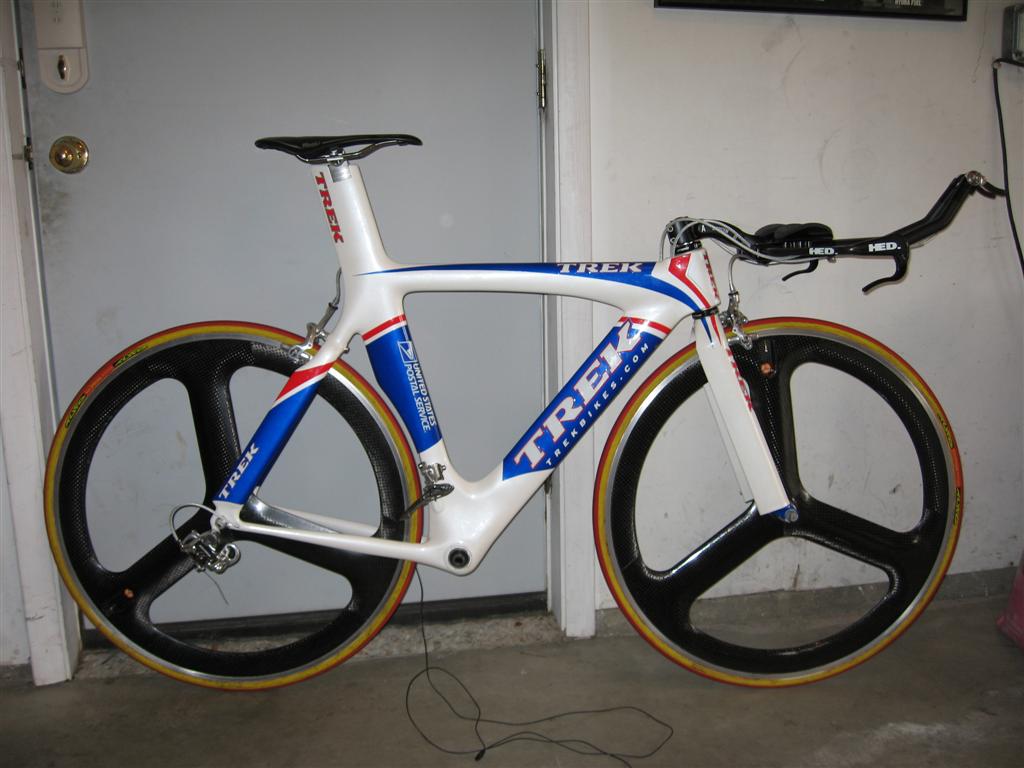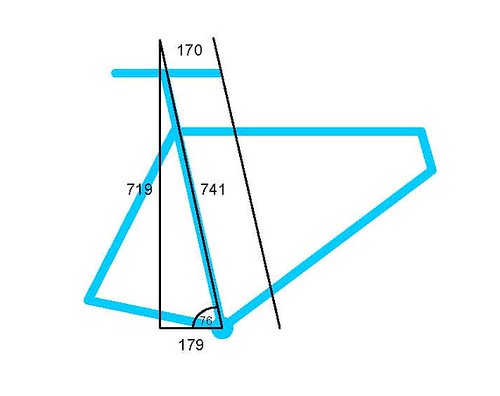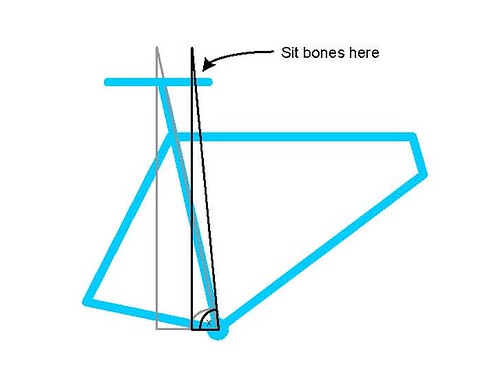FWIW, Dan and I have never discussed this (in fact have not yet met). One minor nit to pick, as I understand it UCI regs won't apply to every racer in every race, but only to NRC calendar events and some other high level races, admittedly a large chunk of races, but strictly speaking technically not "all". With that out of the way, here's one opinion on his latest front page article.
The concept of regulating saddle setback (or “setforward” as the case may be) using an angular instead of a horizontal measurement is rational and in my opinion would provide a more level playing field for riders with different seat heights. Not to put words in Dan’s mouth, but here is a proposed new version of UCI rule 1.3.013, worded along the lines Dan might suggest, with a few blanks to be filled in after someone gets out a CAD program or works out a little trig:
"The center of the straight portion of the saddle’s rail shall lie on or behind a line passing through the bottom bracket spindle and inclined rearward at an angle of [choose an angle, e.g. 77, 79, etc.] from the horizontal. This restriction shall not be applied to the bicycle ridden by a rider in a track sprint event, keirin, 500 metres or 1 kilometre time trials; in that case the angle shall be [chose an angle, e.g. 80, 82, etc.]."
The second sentence about exceptions with a different limit might even be removed if the angles chosen are lenient enough.
However, and here's the only beef I see at this time: It's not unforeseeable that saddles without traditional rails (maybe SDG's I-Beam or a new concept from another company) might potentially be excluded from UCI competition. (That’s how one-legged forks are excluded; UCI regulation 1.3.017 says in part “The distance between the internal extremities of the front forks shall not exceed 10.5 cm...” Note the plural “extremities”.) So as to avoid this potential complication, a slightly different wording that I feel still captures Dan's main intent might read as follows:
"The center of the length of the saddle shall lie on or behind a line passing through the bottom bracket spindle and inclined rearward at an angle of [choose an angle, e.g. 77, 79, etc.] from the horizontal. This restriction shall not be applied to the bicycle ridden by a rider in a track sprint event, keirin, 500 metres or 1 kilometre time trials; in that case the angle shall be [chose an angle, e.g. 80, 82, etc.]."
Notice the changed phrase “center of the length of the saddle” instead of “center of the straight portion of the saddle’s rail”. Likewise, other wording or other “landmarks” of the saddle could reasonably be proposed and considered.
What do you think?
For reference, the current (December 2007) UCI regulation 1.3.013 reads:
The peak of the saddle shall be a minimum of 5 cm to the rear of a vertical plane passing through the bottom bracket spindle (1). This restriction shall not be applied to the bicycle ridden by a rider in a track sprint event, keirin, 500 metres or 1 kilometre time trials; however, in no circumstances shall the peak of the saddle extend in front of a vertical line passing through the bottom bracket spindle.
(1) The distances mentioned in footnote (1) to articles 1.3.013 and 1.3.016 above may be reduced where that is necessary for morphological reasons. By morphological reasons should be understood everything to do with the size and limb length of the rider.
Any rider who, for these reasons, considers that he needs to use a bicycle of lesser dimensions than those given shall inform the commissaires’ panel to that effect when presenting his licence. In that case, the panel may conduct the following test. Using a plumb-line, they shall check to see whether, when pedaling, the point of the rider’s knee when at its foremost position passes beyond a vertical line passing through the pedal spindle (see diagram «Measurements (2)»).
Source: http://www.uci.ch/...LE&id=34033& , page 58.
Damon Rinard
Engineering Manager,
CSG Road Engineering Department
Cannondale & GT Bicycles
(ex-Cervelo, ex-Trek, ex-Velomax, ex-Kestrel)
The concept of regulating saddle setback (or “setforward” as the case may be) using an angular instead of a horizontal measurement is rational and in my opinion would provide a more level playing field for riders with different seat heights. Not to put words in Dan’s mouth, but here is a proposed new version of UCI rule 1.3.013, worded along the lines Dan might suggest, with a few blanks to be filled in after someone gets out a CAD program or works out a little trig:
"The center of the straight portion of the saddle’s rail shall lie on or behind a line passing through the bottom bracket spindle and inclined rearward at an angle of [choose an angle, e.g. 77, 79, etc.] from the horizontal. This restriction shall not be applied to the bicycle ridden by a rider in a track sprint event, keirin, 500 metres or 1 kilometre time trials; in that case the angle shall be [chose an angle, e.g. 80, 82, etc.]."
The second sentence about exceptions with a different limit might even be removed if the angles chosen are lenient enough.
However, and here's the only beef I see at this time: It's not unforeseeable that saddles without traditional rails (maybe SDG's I-Beam or a new concept from another company) might potentially be excluded from UCI competition. (That’s how one-legged forks are excluded; UCI regulation 1.3.017 says in part “The distance between the internal extremities of the front forks shall not exceed 10.5 cm...” Note the plural “extremities”.) So as to avoid this potential complication, a slightly different wording that I feel still captures Dan's main intent might read as follows:
"The center of the length of the saddle shall lie on or behind a line passing through the bottom bracket spindle and inclined rearward at an angle of [choose an angle, e.g. 77, 79, etc.] from the horizontal. This restriction shall not be applied to the bicycle ridden by a rider in a track sprint event, keirin, 500 metres or 1 kilometre time trials; in that case the angle shall be [chose an angle, e.g. 80, 82, etc.]."
Notice the changed phrase “center of the length of the saddle” instead of “center of the straight portion of the saddle’s rail”. Likewise, other wording or other “landmarks” of the saddle could reasonably be proposed and considered.
What do you think?
For reference, the current (December 2007) UCI regulation 1.3.013 reads:
The peak of the saddle shall be a minimum of 5 cm to the rear of a vertical plane passing through the bottom bracket spindle (1). This restriction shall not be applied to the bicycle ridden by a rider in a track sprint event, keirin, 500 metres or 1 kilometre time trials; however, in no circumstances shall the peak of the saddle extend in front of a vertical line passing through the bottom bracket spindle.
(1) The distances mentioned in footnote (1) to articles 1.3.013 and 1.3.016 above may be reduced where that is necessary for morphological reasons. By morphological reasons should be understood everything to do with the size and limb length of the rider.
Any rider who, for these reasons, considers that he needs to use a bicycle of lesser dimensions than those given shall inform the commissaires’ panel to that effect when presenting his licence. In that case, the panel may conduct the following test. Using a plumb-line, they shall check to see whether, when pedaling, the point of the rider’s knee when at its foremost position passes beyond a vertical line passing through the pedal spindle (see diagram «Measurements (2)»).
Source: http://www.uci.ch/...LE&id=34033& , page 58.
Damon Rinard
Engineering Manager,
CSG Road Engineering Department
Cannondale & GT Bicycles
(ex-Cervelo, ex-Trek, ex-Velomax, ex-Kestrel)





















